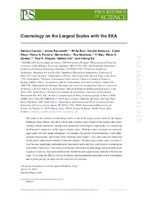Cosmology on the largest scales with the SKA

View/
Date
2014Author
Camera, Stefano
Raccanelli, Alvise
Bull, Philip
Bertacca, Daniele
Chen, Xuelei
Ferreira, Pedro G.
Kunz, Martin
Maartens, Roy
Mao, Yi
Santos, Mario G.
Shapiro, Paul R.
Viel, Matteo
Xug, Yidong
Metadata
Show full item recordAbstract
The study of the Universe on ultra-large scales is one of the major science cases for the Square
Kilometre Array (SKA). The SKA will be able to probe a vast volume of the cosmos, thus representing
a unique instrument, amongst next-generation cosmological experiments, for scrutinising
the Universe’s properties on the largest cosmic scales. Probing cosmic structures on extremely
large scales will have many advantages. For instance, the growth of perturbations is well understood
for those modes, since it falls fully within the linear régime. Also, such scales are unaffected
by the poorly understood feedback of baryonic physics. On ultra-large cosmic scales, two key effects
become significant: primordial non-Gaussianity and relativistic corrections to cosmological
observables. Moreover, if late-time acceleration is driven not by dark energy but by modifications
to general relativity, then such modifications should become apparent near and above the horizon
scale. As a result, the SKA is forecast to deliver transformational constraints on non-Gaussianity
and to probe gravity on super-horizon scales for the first time.
